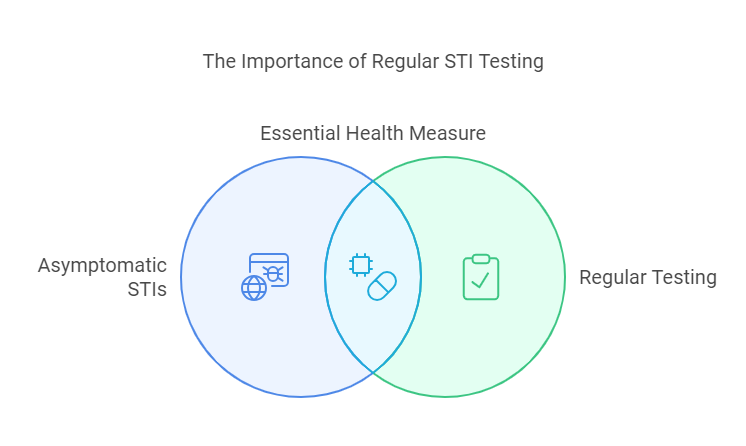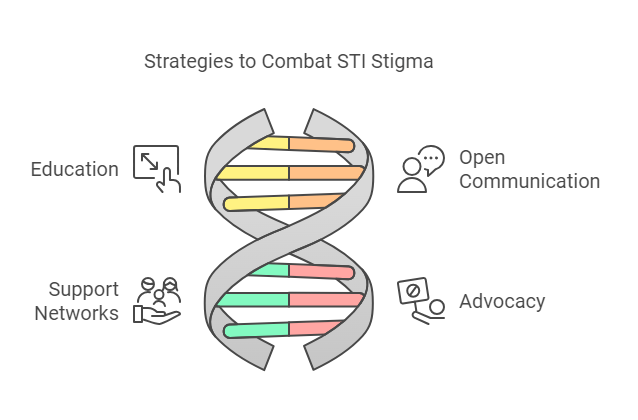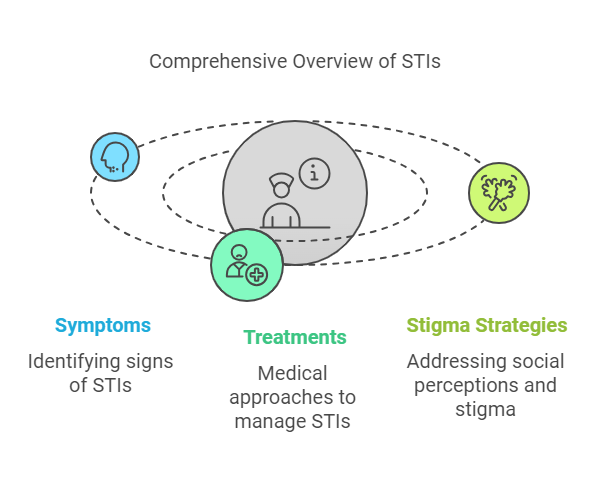Sexually Transmitted Infections are a significant public health concern that affects millions of individuals worldwide. This document aims to provide a comprehensive overview of STIs, including their symptoms, available treatments, and strategies for addressing the stigma associated with these infections. By increasing awareness and understanding, we can promote better health practices and support those affected by the infections.
Here are the latest STI statistics in the UK:
Overall Trends
- In 2023, there were 401,800 diagnoses in England, a 4.7% increase from 2022 ¹.
- The most commonly diagnosed infections were chlamydia (194,970), gonorrhoea (85,223), genital herpes (27,167), and genital warts (26,133) ¹.
STI-Specific Trends
- Chlamydia: Diagnoses remained stable, with 194,970 cases in 2023, compared to 194,244 in 2022 ¹.
- Gonorrhoea: Diagnoses increased by 7.5% from 79,268 in 2022 to 85,223 in 2023 ¹.
- Infectious Syphilis: Diagnoses increased by 9.4% from 8,693 in 2022 to 9,513 in 2023 ¹.
- Genital Herpes: Diagnoses increased by 8.8% from 24,960 in 2022 to 27,167 in 2023 ¹.
Demographic Insights
- Young people (15-24 years) experience the highest diagnosis rates of the most common infections
- Gay, bisexual, and other men who have sex with men (GBMSM) saw increases in bacterial STI diagnoses, including gonorrhoea (9.4%), chlamydia (8.2%), and infectious syphilis (7.3%) ¹.
- Ethnic minority groups, particularly those of black Caribbean ethnicity, had higher rates of STI diagnoses ¹.
These statistics are based on the 2023 report from the UK Health Security Agency ¹.
Symptoms
Sexually transmitted infections can manifest in various ways, and symptoms may differ depending on the type of infection. Some common symptoms include:
- Chlamydia: Often asymptomatic, but may cause abnormal discharge, burning sensation during urination, and pelvic pain.
- Gonorrhea: Similar to chlamydia, it may present with painful urination, discharge, and in some cases, sore throat.
- Syphilis: Characterized by sores or ulcers, particularly in the genital area, followed by rashes and flu-like symptoms in later stages.
- Herpes: Symptoms include painful blisters or sores around the genital area or mouth, along with flu-like symptoms during outbreaks.
- HIV: Early symptoms may resemble flu-like symptoms, including fever, fatigue, and swollen lymph nodes, but can remain asymptomatic for years.
- HPV: Often asymptomatic, but may cause genital warts or lead to certain cancers.
It is essential to note that many sexually transmitted infections can be asymptomatic, making regular testing crucial for sexually active individuals.

Treatments
The treatments vary depending on the specific infection. Here are some common treatments:
- Bacterial Sexually transmitted infections (e.g., chlamydia, gonorrhoea, syphilis): Typically treated with antibiotics. It is crucial to complete the full course of medication and inform sexual partners.
- Viral Sexually transmitted infections (e.g., herpes, HIV, HPV): While these cannot be cured, antiviral medications can help manage symptoms and reduce transmission risk. Vaccines are available for HPV.
- Parasitic Sexually transmitted infections (e.g., trichomoniasis): Treated with prescription medications, usually antibiotics.
Regular screenings and prompt treatment are vital for preventing complications and reducing the spread of STIs.
Dealing with the Stigma
The stigma surrounding sexually transmitted infections can lead to feelings of shame, isolation, and reluctance to seek treatment. Here are some strategies to combat this stigma:
- Education: Increasing awareness about infections, their prevalence, and treatment options can help normalize conversations around sexual health.
- Open Communication: Encouraging open discussions about sexual health with partners, friends, and healthcare providers can reduce feelings of shame.
- Support Networks: Joining support groups or seeking counselling can provide emotional support and help individuals cope with the stigma.
- Advocacy: Supporting public health initiatives that promote sexual health education can help reduce stigma on a larger scale.
By addressing the stigma associated with sexually transmitted infections, we can create a more supportive environment for those affected and encourage proactive health behaviours.

What to do if you think you have a Sexually Transmitted Infection
If you suspect that you may have a sexually transmitted infections, there are a few important steps you should take:
1. Get Tested: The first and most essential step is to get tested. Several clinics and healthcare providers offer confidential STI testing. Whether you have symptoms or not, if you've been sexually active and have reason to believe you might have been exposed to an infection, getting tested is critical.
2. Seek Medical Help: If the test comes back positive, the next step is to seek immediate medical attention. Reach out to a healthcare professional who can provide guidance on the necessary steps for treatment.
3. Communicate with your partner(s): It can be difficult, but it's essential to inform your current and past partners who might have been exposed. They need to be aware so they can also get tested and, if necessary, treated.
4. Follow the treatment plan: Some infections are treatable, while others can only be managed. It's crucial to adhere to the treatment plan given by your healthcare provider. This may include taking medication as prescribed and attending all follow-up appointments.
5. Practice Safe Sex: Always practice safe sex to prevent further spread of the infection. This includes using barriers like condoms or dental dams and discussing STI statuses with future partners.
Remember, it's normal to feel scared or anxious, but with prompt action and proper medical care, most sexually transmitted infections can be managed effectively.
Conclusion
STIs are a common health issue that requires awareness, understanding, and compassion. By recognizing the symptoms, seeking appropriate treatments, and addressing the stigma, we can foster a healthier society. Regular testing and open conversations about sexual health are essential steps in promoting well-being and reducing the impact of STIs on individuals and communities.
If you need any further information or assistance with this article, don't hesitate to Contact Us
The content of this post is provided for informational purposes only. It is essential to consult with a qualified healthcare professional before making any decisions regarding your health or wellness. The author is not a licensed medical professional, and this information should not be considered medical advice.
The content of this post is provided for informational purposes only. It is essential to consult with a qualified healthcare professional before making any decisions regarding your health or wellness. The author is not a licensed medical professional, and this information should not be considered medical advice.
Karen Blake
BAHN-NLP
TFT-DX
The content of this post is provided for informational purposes only. It is essential to consult with a qualified healthcare professional before making any decisions regarding your health or wellness. The author is not a licensed medical professional, and this information should not be considered medical advice.















